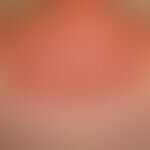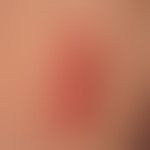Synonym(s)
DefinitionThis section has been translated automatically.
Frequent, acute, toxic dermatitis as a result of excessive exposure to ultraviolet radiation. It occurs mainly in children and adolescents who are accustomed to the sun and have fair skin and lack experience in exposure to the sun. More than 75% of all sunburns are observed in the age group up to 20 years.
Occurrence/EpidemiologyThis section has been translated automatically.
About 41% of all Germans suffer from dermatitis solaris once a year. In the group of 18-29 year olds the frequency/year was 71%, in the >60 year olds 16%. In the group of <30-year-olds about 25% more than 1x/year had dermatitis solaris.
You might also be interested in
EtiopathogenesisThis section has been translated automatically.
Phototraumatic reaction with cytotoxic process by the UVB fraction of light. Although the pathophysiology of thermal burns and dermatitis solaris is similar, the time curve is different. In burns, erythema occurs within a few minutes, in dermatitis solaris this is observed with a time delay within 3-5 hours after UV irradiation with a reactive maximum after 12-24 hours.
ManifestationThis section has been translated automatically.
Children and adolescents preferentially affected
Especially for persons with low pigmentation(skin types I and II).
It is more common in spring and summer or after a first stronger exposure to the sun after a longer, missing exposure.
Frequently also when staying in high mountain areas and at the sea (lack of UV-absorbing dust and mist particles). In addition, in these regions, UV reflection by sand, water and snow.
ClinicThis section has been translated automatically.
Dermatitis begins within the first 6 hours, reaches its peak after 12-24 hours and, depending on the intensity of the toxic reaction, subsides after 72 hours.
At the beginning, the skin shows flat (usually large) erythema that is sharply limited to the area of exposure, itchy and painful erythema and sometimes also extensive swelling due to oedema formation and a feeling of heat.
In the case of more severe skin damage, intensive pain symptoms.
Depending on the extent of the damage, formation of small and larger subepithelial blisters.
Healing with crust formation, coarse lamellar desquamation and possibly permanent hyperpigmentation; scarring only in the case of severe damage.
In case of infestation of large skin areas system signs such as: fever, general feeling of illness, desiccation, drop in blood sugar levels.
Complication(s)(associated diseasesThis section has been translated automatically.
Increased risk for the development of epithelial (see carcinoma of the skin below) and melanocytic malignancies (see melanoma malignes)
TherapyThis section has been translated automatically.
External therapyThis section has been translated automatically.
In the erythematosus stage: moist compresses, cooling external agents such as creams, lotions and foam sprays (e.g. 0.1% hydrocortisone-17-butyrate cream [e.g. Laticort cream]). In a domestic environment, tap water compresses (moisten a clean cotton cloth) can also be applied. Never use ice or cold packs, as there is a risk of local cold damage. Cooling has an important function in reducing pain.
For severe burns: Short-term medium to strong glucocorticoids as cream or lotion such as 0.1% betamethasone lotio R030, 0.1% hydrocortisone butyrate (e.g. Alfason), 0.25% prednicarbate cream (e.g. Dermatop), 0.1% methylprednisolone cream (e.g. Advantan). This therapeutic approach is based on clinical experience. There is no assured knowledge regarding a positive effect of this therapy!
In the vesiculosum stage: Medium-strength glucocorticoids (see above). Moist compresses, if necessary with antiseptic additives, e.g. polihexanide (Prontosan) or octenidine (Octenisept) to avoid secondary infections, see also burn.
Internal therapyThis section has been translated automatically.
Immediately after sun exposure, acetylsalicylic acid (e.g. ASA) once 1 g and Vit. C (e.g. Cebion Tbl.) 400-1000 mg. NSAIDs are no longer generally recommended due to a lack of study results. They probably only have an analgesic effect! In severe cases , glucocorticoids, systemic p.o. in medium doses such as prednisolone 40-60 mg/day (e.g. Decortin H), quickly taper off.
A single dose of 50,000-200,000IU vitamin D3 is recommended. D3 combines with endogenous retinoids produced by UV rays, which promotes the differentiation of anti-inflammatory macrophages (Mc Grath et al. 2024).
ProphylaxisThis section has been translated automatically.
According to a Forsa survey in 2015, 17% never use a sunscreen product, men use it less often than women (14%/21%). 70% of those surveyed do not use intensive sunbathing. 63% protect themselves with clothing or headgear. 36% consistently avoid the sun at lunchtime.
Phytotherapy externalThis section has been translated automatically.
Different phytotherapeutics are mentioned: Avenae fructus, Avenae stramentum, Balloon vine, Calendulae flos, Acetic clay, Hamamelidis folium, Hyperici herba, Matricariae flos, Populi gemmae, Ratanhiae radix
Further quark application, cooling
Note(s)This section has been translated automatically.
It is important to know about drugs and products that increase photosensitivity (see phototoxicity below).
Dermatitis solaris can act as a trigger factor for other diseases (see also light dermatoses) - e.g. psoriasis vulgaris, systemic lupus erythematosus.
LiteratureThis section has been translated automatically.
- Amelot A et al (2014) Phototoxic reaction associated with Malarone (atovaquone/proguanil) antimalarial prophylaxis. J Dermatol 41:346-348
- DAK press release: Sunburn. DAK press release 2016
- Jaworski K et al (2014) Cutaneous adverse reactions of amiodarone. Med Sci Monit 20: 2369-2372
- Lamp HP (2015) Acute phototoxic reaction in a century cyclist. Clin J Sport Med 25:e28
- Proksch E et al. (2007) Rational treatment of patients with 1st degree burns. dermatologist 58: 604-610
- Zinc A et al (2014) Images in clinical medicine. Phototoxic dermatitis. N Engl J Med 371:559
Incoming links (32)
Acanthomas, disseminated epidermolytic; Acetic acid alumina; Apoptosis; Avenae stramentum; B-clear; Benzocaine; Betamethasone valerate emulsion hydrophilic 0,025/0,05 or 0,1 % (nrf 11.47.); Calendulae flos; Chlorophenoxamine; Cholinstearate; ... Show allOutgoing links (29)
Acetic acid alumina; Acetylsalicylic acid; Avenae fructus; Avenae stramentum; Balloon vine; Betamethasone valerate emulsion hydrophilic 0,025/0,05 or 0,1 % (nrf 11.47.); Bubble; Calendulae flos; Carcinoma of the skin (overview); Glucocorticosteroids systemic; ... Show allDisclaimer
Please ask your physician for a reliable diagnosis. This website is only meant as a reference.






















